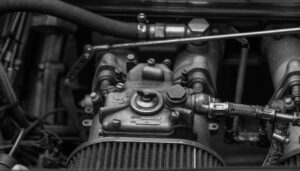How Do Carburettors Work?
How do generators work? That is the question that we’re going to be answering right here on our blog. We’ll be spreading this over a series as we deconstruct generators and their components, telling you how they work, so you know a little bit more about their construction.
For many people reading this who work in engineering or mechanical jobs, or have an interest in machines, you’ll likely already know the ins and outs of these components. However, if you’re looking to brush up on your knowledge of machinery, or are learning this for the first time, we hope our series will help you.
In this instalment, we’ll be looking at how carburettors work and why they serve an important role within generators.
The Basics of Combustion
As we all know, for any kind of combustion, whether it is a prolonged fire, like a candle burning, or an explosion, like a popping a helium-filled balloon, there has to be three things. The first is fuel, which can take the form of solid, liquid or gas – this could be petrol in your car’s tank or wood on a fire. The second ingredient is heat, such as friction from striking a match. Finally, you need oxygen; without this, there would be no fire.
Whether in a car or a generator, engines use combustion to create power, either to turn into electricity or to send power to the wheels. However, there must be components in place to manage the feeding of the fuel and air into the engine. This could be to increase or decrease the amount being added or to manage the amount of each.
The Role of a Carburettor in an Engine
The primary role of a carburettor is to mix fuel with air/oxygen before it is introduced to the engine for combustion. It’s also responsible for managing the quantity of each within the mixture to ensure efficient combustion and to regulate the total amount, accommodating any increases or decreases in power.
How Does it Work?
Although this all sounds very complicated, the mechanics of a carburettor are actually very simple. A carburettor consists of an air pipe in the shape of a venturi (squeezed in the middle). This shape serves the purpose of increasing airflow speed in the middle section, as the air is channelled through a smaller space resulting in increased pressure.
Above the venturi is another valve called the choke, which controls the amount of air that passes through the pipe. Beneath the venturi, there is a butterfly valve which regulates the flow of air and fuel into the engine, capable of being completely sealed off.
The reason for two valves is that in the middle of the venturi, at the narrowest section of the pipe, is a small tube which links to a fuel tank housed within the carburettor. As air flows through the venturi pipe, fuel is sucked out of the tank and into the main pipe to create a specified ratio of fuel to air. This mixture is then added to the engine for combustion.
The valve above the venturi, the choke, is used for starting an engine from cold. It’s important to note that fuel vaporises less easily when the engine is cold; therefore, a more fuel-rich mixture is required. A richer mixture makes combustion easier and will allow the engine to warm up while reducing the ratio of fuel to air until it is performing at optimum efficiency.
The purpose of the valve below the venturi, the throttle, is to control how much mixture in total is reaching the engine. This valve will be connected to the accelerator peddle in a car or handlebar on a motorbike, or will be controlled manually on a generator.
The Float-Feed Chamber
The mini fuel tank that forms part of the carburettor is called the float-feed chamber, and this is a particularly important component in the overall design. The float-feed chamber is where fuel is pulled from when air is sent down the main pipe through the venturi. Inside the tank, there is a float and a valve which connects the chamber to the primary fuel tank.
As fuel is pulled into the engine through the air pipe, the level of fuel in the tank decreases, causing the float to drop. When the float reaches a certain level within the tank, the valve opens and allows fuel to flow into the chamber. Once the chamber has enough fuel, the valve closes again.
It’s worth noting that in many modern cars, carburettors have been replaced by fuel injection systems which offer increased fuel efficiency and are a more direct method of providing power, although they are much trickier to repair and maintain. In generators, however, carburettors are still as popular as ever. That being said, they can cause problems with the generator if not correctly maintained, which is something you need to be aware of.
This concludes our brief guide to carburettors, make sure to check out our blog for more information on how generators work and how we carry out our other range of services such as load bank testing and LPG conversion.
Alternatively, if you’re looking to contract these services, get in touch with us at Edge Technology today!














